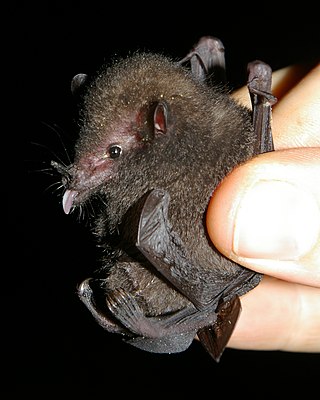Craugastor underwoodi is a species of frog in the family Craugastoridae. It is found in Costa Rica and Panama. Its natural habitats are subtropical or tropical moist lowland forests, subtropical or tropical moist montane forests, pastureland, plantations, and heavily degraded former forest.
Underwood's pocket gopher is a species of rodent in the family Geomyidae. It is endemic to Costa Rica. Some authors classify it in the genus Orthogeomys, but recent research has allowed this and its related species to be classified in the genus Heterogeomys.

Underwood's bonneted bat is a species of bat in the family Molossidae.

Underwood's long-tongued bat is a species of bat in the family Phyllostomidae. It is the only species within the genus Hylonycteris. It is found in Belize, Guatemala, Mexico, Nicaragua, and Panama. Hylonycteris underwoodi feed on nectar, pollen grains, agave and fruits. This choice of food has allowed them to gain the ability of hovering flight, thereby evolving their body mass and size to compensate for the same.

Gymnophthalmus underwoodi, called commonly Underwood's spectacled tegu, is a species of microteiid lizard, which is found in South America and on certain Caribbean islands.
Halysidota underwoodi, or Underwood's tussock moth, is a moth of the family Erebidae. It was described by Walter Rothschild in 1909. It is found in Mexico, Guatemala, Nicaragua, Costa Rica, Panama, Colombia, Venezuela, Ecuador, Peru and Bolivia.

Apostolepis is a genus of snakes in the subfamily Dipsadinae. However, the familial placement differs among sources. It has also been placed in the family Colubridae, subfamily Dipsadinae or Xenodontinae, or in the family Xenodontidae. The genus Apostolepis is endemic to South America.

Eucorethra underwoodi is a species of phantom midges.
Homonota underwoodi is a species of gecko, a lizard in the family Phyllodactylidae. The species is endemic to Argentina.
Sphaerodactylus underwoodi, also known commonly as Underwood's least gecko or the Turks Islands geckolet, is a small species of lizard in the family Sphaerodactylidae. The species is endemic to Grand Turk Island.

Cecil Frank Underwood was a British scientific collector of mammal and bird specimens in Central America.
Apostolepis cearensis, the Caatinga blackhead or Gomes's burrowing snake, is a species of snake in the family Colubridae. It is endemic to Brazil.
Apostolepis dorbignyi, also known commonly as the Bolivian burrowing snake and Dorbigny's blackhead, is a species of snake in the family Colubridae. The species is native to western South America.
Apostolepis gaboi, also known commonly as the sand dunes blackhead and the cobra-rainha das dunas in Brazilian Portuguese, is a species of snake in the family Colubridae. The species is endemic to Brazil.
Apostolepis lineata, the hognose lineate blackhead, is a species of snake in the family Colubridae. It is endemic to Brazil.
Apostolepis longicaudata, the Piauí blackhead or longhead burrowing snake, is a species of snake in the family Colubridae. It is endemic to Brazil.
Apostolepis multicincta, Harvey's blackhead, is a species of snake in the family Colubridae. It is endemic to Bolivia.
Apostolepis niceforoi, the Colombian blackhead or Amazon burrowing snake, is a species of snake in the family Colubridae. It is endemic to Colombia.
Apostolepis polylepis, the hawbeack blackhead, is a species of snake in the family Colubridae. It is endemic to Brazil.





